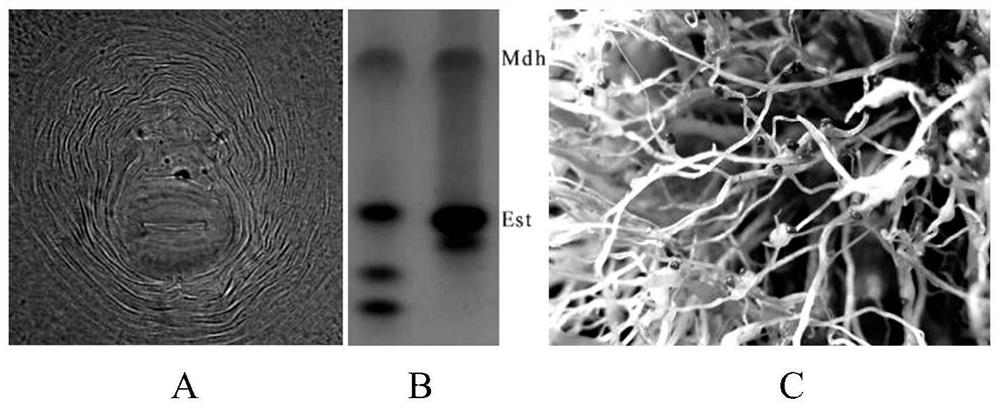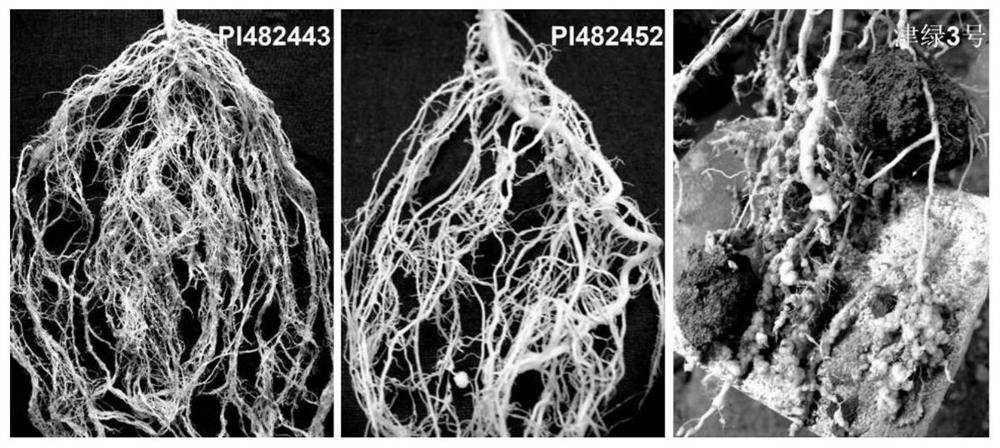Cucumis sativus grafting method and application thereof in meloidogyne spp. control
A technology of root-knot nematode and root-knot nematode, applied in grafting, fruit tree cultivation and other directions, can solve the problem of low level of resistance of pumpkin to root-knot nematode, and achieve rich choices, reduce use, improve income and product quality. Effect
- Summary
- Abstract
- Description
- Claims
- Application Information
AI Technical Summary
Problems solved by technology
Method used
Image
Examples
Embodiment 1
[0038] Example 1, Screening and identification of root-knot nematode resistant cucumber germplasm resources
[0039] 1. Collection of germplasm resources
[0040] Collected 110 germplasm resources of the genus Cucumber from home and abroad, including 4 North China type cucumber materials, 2 South China type cucumber materials, 2 fruit cucumber materials, 2 white cucumber materials, 50 cucumber wild resources, interspecific hybrid introgression There are 46 copies of materials and 4 copies of semi-wild resources. Some representative materials are listed in Table 1.
[0041] 2. Identification of nematode pathogens and preparation of inoculum
[0042] (1) Identification and propagation of nematode pathogens
[0043] Cucumber roots infected with root-knot nematodes were collected from the field, and light yellow, large and plump high-quality single egg masses were picked from the cucumber root knots, inoculated into the infected tomato roots pre-cultivated in sterilized soil, a...
Embodiment 2
[0065] Embodiment 2, the grafting adaptability test of anti-root-knot nematode germplasm
[0066] 1. Seedling cultivation
[0067] 2 rootstocks, which are the selected Cucumis metuliferus lines PI 482443 and PI482452, and 3 scions, including dense thorn cucumber 'Jinlu 3', white cucumber 'Baiye San', and fruit cucumber 'corn Mini'. The rootstock was raised in a nutrient pot, and the scion was directly sown on the seedbed. The rootstock was sown 20 days earlier than the scion. After emergence, normal fertilizer and water management was carried out to cultivate strong seedlings.
[0068] 2. Screening of grafting methods
[0069] Through the screening of suitable grafting methods, two methods of grafting and cleaving were determined to be used for grafting.
[0070] Insertion: first dig out the true leaves and growth points of the rootstock, and use a bamboo stick to insert obliquely from the base of the main vein of one cotyledon to the other cotyledon to a depth of 5-7 mm; t...
Embodiment 3
[0079] Embodiment 3, the application of anti-root-knot nematode cucumber stock
[0080] 1. Selection of test site
[0081] The field experiment was arranged in the solar greenhouse of Shun'an Village, Fafa Town, Liangzhou District, Wuwei City, Gansu Province. The plot is a cucumber stubble field. Cucumbers have been planted continuously for 5 years. The occurrence of root-knot nematodes is serious. The average density of root-knot nematodes in the soil is 71.3 / 100g dry soil.
[0082] 2. Test treatment
[0083] A total of 6 treatment combinations were set up in the experiment, among which No. 1, No. 2 and No. 3 were grafting cultivation. The rootstocks were black-seeded pumpkin, Cucumis metuliferus (Cucumis metuliferus) strains PI 482443 and PI 482452, and the scions were Jinlu No. 3. The whole growing season No nematicides were applied, No. 4, 5, and 6 were self-rooted cultivation of Jinlv No. 3, No. 4 did not apply nematocides, No. 5 put plant nematode powder in the planti...
PUM
 Login to View More
Login to View More Abstract
Description
Claims
Application Information
 Login to View More
Login to View More - R&D
- Intellectual Property
- Life Sciences
- Materials
- Tech Scout
- Unparalleled Data Quality
- Higher Quality Content
- 60% Fewer Hallucinations
Browse by: Latest US Patents, China's latest patents, Technical Efficacy Thesaurus, Application Domain, Technology Topic, Popular Technical Reports.
© 2025 PatSnap. All rights reserved.Legal|Privacy policy|Modern Slavery Act Transparency Statement|Sitemap|About US| Contact US: help@patsnap.com



